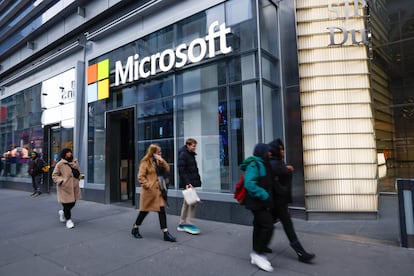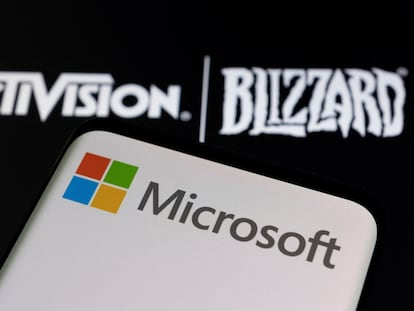Microsoft has its iPhone moment: The tech giant is now worth $3 trillion
The company has achieved record results thanks to its cloud business and artificial intelligence. It has edged ahead of Apple as the most valuable listed group in the world


A few weeks ago Scott Guthrie, one of Microsoft’s veteran programmers, was looking for an example to illustrate the furor caused by artificial intelligence (AI) in the company’s products. Thanks in large part to AI, Microsoft’s value recently surpassed the $3 trillion barrier and has overtaken Apple as the most valuable company on the stock market.
Guthrie, who leads Azure, the tech giant’s cloud computing platform, has been with the company for several decades. He said that the high demand is similar to the high expectations caused by the launch of Windows 95, the program that promised to revolutionize home computing and whose release saw long lines of people form outside electronics stores. Perhaps that comparison will not work for young people — who do not know what it is like to wait in line to buy an operating system — and they will better visualize what AI has meant for the company created by Bill Gates if the reference is the consumer frenzy that is whipped up at the launch of each new Apple product. So yes, Microsoft is having its iPhone moment.
The tech giant based in Redmond, Washington, published the results of its second quarter last week — the company’s fiscal year, which ends in June, is not aligned with the calendar year. It was the period in which the company made record profits thanks to its cloud services.
Between October and December, Microsoft had a turnover of $62.02 billion, 17% higher, and increased its profits by 33% to $21.87 billion. “We have gone from talking about artificial intelligence to applying it at scale in all layers of our products,” said Satya Nadella, CEO of the company, during his conference with analysts. Microsoft has been trying to sell itself to the public as an AI company for months. For this reason, the head of Marketing was replaced in October after almost a decade in office. The baton has been taken up by Takeshi Numoto, Azure’s sales manager.
Microsoft’s shares have risen 57% in the last year and the market capitalization is $3.08 trillion. This interest from investors is largely in response to the agreement that Microsoft has had since 2019 with OpenAI and its star product, ChatGPT. The agreement between the parties was extended “long-term” last year, in an operation in which the firm chaired by Sam Altman secured revenues of $13 billion. Each Microsoft share is worth $414, but analysts still see potential for additional appreciation. Dan Ives of Wedbush Securities, an investment firm in Los Angeles, places his price target at $450, 8.6% above his current valuation.

Amy Hood, the company’s chief financial officer, said last week that a good part of the profits made by Azure were generated by the increased use of AI. The company expects this trend to continue in 2024 as more and more companies incorporate the technology. In fact, at the end of January it was announced that Vodafone will invest $1.5 billion in the cloud platform to transform the digital experience of 300 million users.
However, Microsoft’s second youth has its darker side. The technology giant laid off more than 20,000 employees in 2023, mainly salespeople and workers in the customer service arena. Recently, the company announced another cut in Microsoft Gaming, its gaming division, where it laid off 1,900 employees, accounting for 8% of the total. Most worked at Activision Blizzard, a company Microsoft acquired last year.
To establish itself at the forefront of the AI revolution, a position that Microsoft leads along with Nvidia and AMD, the company aims to not only attract large firms as clients, but also small and medium-sized corporations. With this in mind, Copilot began to be marketed last June. The program uses ChatGPT 4 as an engine and is aimed at small businesses. And along these lines, last December Microsoft launched a $20 subscription focused on entrepreneurs looking to automate their companies.
“The results have been impressive,” said Rajesh Jha, vice president of Experience and Devices, at an event organized by Barclays last month. “Between 68% and 72% of users recognize that Copilot made them more efficient and improved the quality of their work, allowing them to focus on what is inherently human work: creative, reflective, or collaborative […] More than 55% of users feel more creative with AI,” Jha stressed.
Microsoft says it has 1.3 million subscribers to its GitHub Copilot service, which allows programmers to write code with the help of AI. The number of subscribers to the program has grown 30% in the last three months. The strategy until the end of 2023 was to sell the tool to large companies for a minimum subscription of $300 per month ($30 per user). But Copilot will also be available to all those who have Office in the cloud, and they will be able to use it to create content in the company’s other programs such as Excel, PowerPoint, and Office, which has 400 million paid downloads.
One in three users of the Microsoft 365 platform says that AI does research, writing, and summarizing tasks faster. In the last two months, Microsoft has signed contracts with companies such as Honda and Pfizer to make Copilot available to all their employees. The company is convinced that the use of technology will be so everyday that it has made the first major modification to its keyboards in three decades to include a key that launches the assistant. “In 2024, AI will be a first-class part of all computers,” said the company’s top executive.
According to Nadella, AI has caused Windows downloads to increase by 50% year-on-year. Yes, there are people lining up to use the latest Microsoft operating system. Unlike the launch of Windows 95, no one sees these long lines. And it’s all thanks to the cloud and the popularization of AI.
Sign up for our weekly newsletter to get more English-language news coverage from EL PAÍS USA Edition
Tu suscripción se está usando en otro dispositivo
¿Quieres añadir otro usuario a tu suscripción?
Si continúas leyendo en este dispositivo, no se podrá leer en el otro.
FlechaTu suscripción se está usando en otro dispositivo y solo puedes acceder a EL PAÍS desde un dispositivo a la vez.
Si quieres compartir tu cuenta, cambia tu suscripción a la modalidad Premium, así podrás añadir otro usuario. Cada uno accederá con su propia cuenta de email, lo que os permitirá personalizar vuestra experiencia en EL PAÍS.
¿Tienes una suscripción de empresa? Accede aquí para contratar más cuentas.
En el caso de no saber quién está usando tu cuenta, te recomendamos cambiar tu contraseña aquí.
Si decides continuar compartiendo tu cuenta, este mensaje se mostrará en tu dispositivo y en el de la otra persona que está usando tu cuenta de forma indefinida, afectando a tu experiencia de lectura. Puedes consultar aquí los términos y condiciones de la suscripción digital.
More information
Archived In
Últimas noticias
Most viewed
- Reinhard Genzel, Nobel laureate in physics: ‘One-minute videos will never give you the truth’
- Oona Chaplin: ‘I told James Cameron that I was living in a treehouse and starting a permaculture project with a friend’
- Pablo Escobar’s hippos: A serious environmental problem, 40 years on
- Charles Dubouloz, mountaineering star, retires at 36 with a farewell tour inspired by Walter Bonatti
- Why we lost the habit of sleeping in two segments and how that changed our sense of time










































